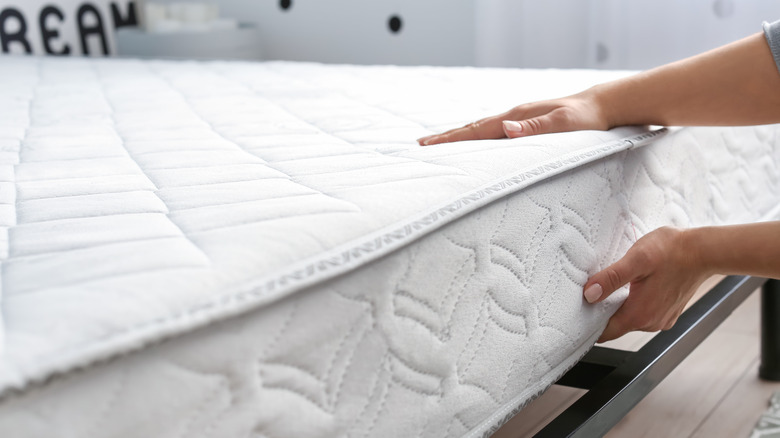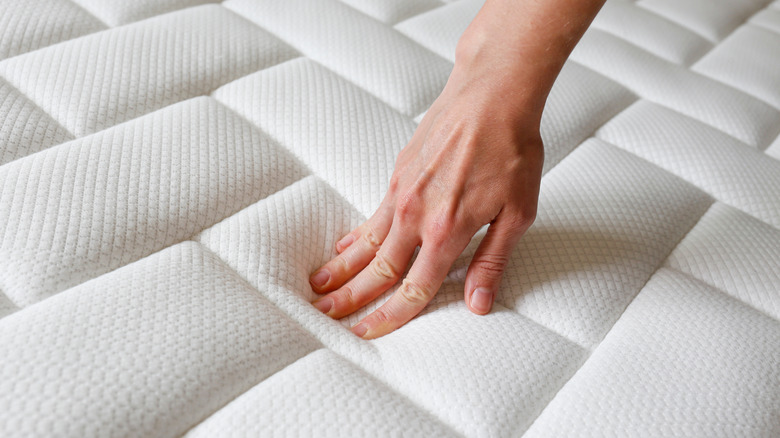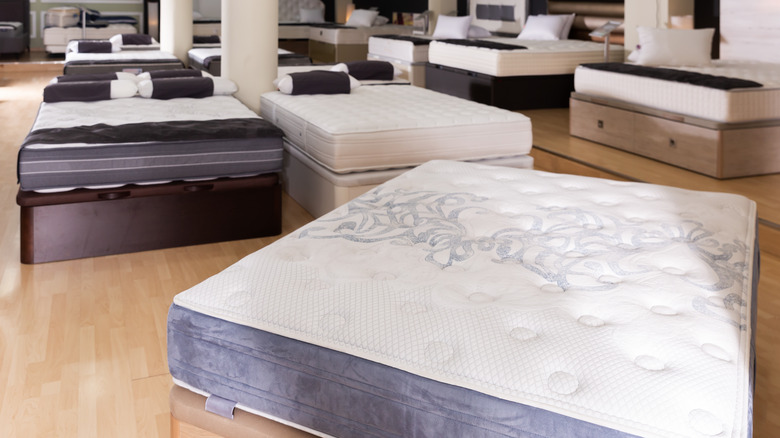Mistakes Everyone Makes When Buying Mattresses
If you've recently realized your mattress is past its prime, it may be time to purchase a new one. Mattress buying isn't exactly a regular job. According to Dreams, the mattress industry recommends replacing your mattress approximately every eight years. It pays to think about switching up your bed once it gets past its prime. The age and cleanliness of your mattress can affect the quality of your sleep. Once you notice the comfort, support, or construction deteriorating, it's time to say out with the old and in with the new.
We don't blame you for wincing at the thought of buying a new mattress. It's a big, expensive job. Since it's a task we don't have to do often, it's easy to get it wrong. Once you're stuck with a bad mattress in your home, it's not exactly a piece of cake to take it to the store for a refund. We've decided to put together the ultimate guidebook to potential mistakes you can make when buying a new mattress and how to avoid them. Follow these tips for the best night's sleep of your life.
Going for the cheapest mattress
If you've ever had to buy a new mattress, you know how the price varies. While some budget options start around the $250 price point, more luxurious options can skyrocket in price to over $3,000. According to the Sleep Foundation, the average cost of a queen-size hybrid mattress made of coil and foam is about $2,050.
For most folks, that's a lot of money to think about spending in one go. However, don't let that thought make you go for the cheapest option. Mattress price is affected by many factors, including material, construction, warranty, and overall quality. As a general rule of thumb, the less you spend, the lower the quality of your mattress. Low-quality mattresses will deteriorate faster, causing you to spend even more money to replace them. Try to put aside a healthy chunk of change for your new mattress. There are plenty of queen-size budget mattresses costing around $600 and mid-range options $1,000. Think of your new bed as an investment.
Not selecting a mattress for your sleeping position
We all sleep differently, and most people have a preferred position when they hit the hay. Did you know that you should be buying your mattress with this position in mind? It's not a one-size-fits-all solution, folks.
According to Healthline, it's good to think about which side you sleep on when choosing a new mattress, as different levels of support can better accommodate your usual position. For side sleepers, your shoulders and hips tend to take on a little more pressure through the night, so it's good to opt for softer mattresses. Pillow-top mattresses and mattresses made with memory foam are the best options here. If you prefer to sleep on your back, focus on keeping your spine well-aligned. A firmer mattress, made of foam or a foam-coil combination, can help you sleep better. Firm mattresses also offer support for those who sleep on their stomachs. However, people who sleep on their stomachs should try and change positions, as this arrangement can put pressure on the neck and back. Pillows can also help provide a better night's sleep for your sleep position.
Make sure you try before you buy
In a world where online mattress delivery stores are 10 a penny, it's infinitely easier to have your mattress delivered at the click of a button. However, what happens when it gets to your house and it's not right? How do you return such a cumbersome item? For something that you're going to be spending a lot of time on, it's far more prudent to get down to a store. According to Sleep Foundation, trying out a mattress before you buy it allows you to see how it feels and test its firmness and comfort levels, and it may also offer you opportunities to negotiate a lower price. You can also discuss your options with a salesperson, who may help you make a better choice. These reasons are probably why 92% of people prefer to try before buying (via SleePare).
However, buying in-store does have its downsides. In-person retailers like IKEA may have a less comprehensive selection than what you'd find online, and mattresses can also be pricier. Your shipping cost may also be higher than an online alternative. Bear in mind that many online mattress retailers now offer generous return policies, so if you end up buying one online and it's not right, don't be afraid to send it back.
Consider your body type
Just as no two nights of sleep are the same, no two bodies are perfectly alike. Failing to consider your body type when shopping for a new mattress is a mistake many people make. According to Good Housekeeping, it all comes down to the firmness of the mattress. If you have a smaller or lighter frame, you tend to place less pressure on a bed. A firmer mattress won't sink enough to take pressure from your joints. Softer mattresses can help add comfort.
For people with larger frames, a softer mattress might make you sink too much and misalign your spine. Over time, this can lead to back pain. Firmer mattresses will help support your frame and back, preventing you from throwing your body out of alignment. It's also worth considering your regular sleeping position when choosing a mattress. For example, side sleepers with heavier frames should choose a bed with a medium firmness to get the best of both worlds.
Getting ripped off on the price
There's no getting around the fact that mattresses aren't cheap. However, people often spend way too much on them. According to Vox, it's easy to get ripped off when shopping for a new mattress because most customers don't have much experience with the mattress industry. Since we generally only buy beds once or twice a decade, we are less familiar with what constitutes a fair price, leading to hugely inflated prices. Furthermore, mattress retailers will often game their pricing system to make you pay more by inventing a wildly high "standard" price and offering an incredible "discount" to make it look more appealing. However, the discounted price is the actual value of the mattress.
The price of a mattress can be negotiable, and you often have the power to bring the price down if you're shopping on a budget. The best way to do this is by harnessing the power of the internet. When selecting a mattress in a store, search for the same one online and see if you can find any retailers that offer it at a lower price. Then, ask the store if they can beat it. They might decline, but there's a good chance you will walk out of the store with a deal.
Forgetting your partner's needs
Being in a relationship usually comes with its fair share of compromises on both sides, especially when shopping for a new mattress. Blindly buying a mattress without taking your partner's needs into account may result in a source of tension you hadn't anticipated. You will spend a lot of time on the mattress, so it's essential to consider your respective sleep patterns. According to MattressNextDay, if your partner goes to bed before or after you, buying a firmer mattress with less movement may save a lot of irritated wakes up.
There are also factors like temperature and noise to consider. Mattresses that retain too much heat or make noise can be a source of discomfort for couples sleeping together. Try to choose beds with materials that can minimize this discomfort, like latex mattresses. For extra-fidgety sleepers, a memory foam mattress can help reduce the motion felt on the other side of the bed when one of you is rolling over.
Settling for a mattress
We wouldn't blame you if you found mattress shopping tiring. However, beware of decisions made due to fatigue, especially if that means settling for a mattress. Just think about how much time you spend in bed. According to Dreams, we spend about 26 years in bed. Plus, we spend seven years trying to fall asleep. That's a lot of time spent lying on a mattress you don't love.
It's best to continue persevering until you find the perfect mattress. Settling for a so-so bed is an expensive compromise. It might even affect the quality of your sleep and contribute to bodily aches and pains (via Sleep Foundation). The effects of poor sleep extend far beyond being a little cranky the next day. Chronic poor sleep can result in increased stress and memory disorders, hypertension, cardiovascular disease, colorectal cancer, and higher mortality rates in men (via Nature and Science of Sleep).
Not taking firmness into account
Buying a new mattress is a dizzying thrill ride. You'll probably see many terms that don't crop up very often, like memory foam, pocketed coils, motion isolation, off-gassing, and sinkage. However, there's one term you'll want to pay more attention to than others. According to Sleepopolis, mattress firmness is a primary factor in buying that many people ignore. Firmness directly relates to how well you'll sleep, depending on your sleep style.
The mattress firmness level is on a scale of 1-10, with the softest mattresses being lower. Mattresses with firmness of either 1 or 10 are extremely rare, and usually, they fall somewhere in-between. The majority of beds come in at a 6 or 7, or medium-firm. Since everyone experiences firmness differently, no firmness level is the best. However, it's good to start with your usual sleeping position and body type. Remember, firmness does not equate to support! Firmness describes how the mattress feels when lying on it, whereas support describes how well it keeps your spine aligned.
Think about temperature
Some humans run hot, and some run cold. If you're someone who overheats at night, keep this in mind when shopping for a new mattress. According to Good Housekeeping, choosing a mattress with cooling technology may help reduce your temperature while you sleep. This tip is essential for those who live in warmer climates or have a higher body temperature.
However, it's good to stay on the lookout for mattress components that will warm you up during the night. For example, cool-to-the-touch covers can end up trapping heat. Memory foam mattresses retain temperatures and absorb heat. These might be a better choice for people who get chilly while sleeping. Instead, look for beds with built-in cooling technologies, particularly phase-change technologies. This feature helps regulate temperature based on different points in the night. If you tend to overheat during the night, look for energy-powered options that cool down mattresses with air or water circulation. These can be more cumbersome and expensive to run. Alternatively, you can also keep an eye on your air conditioner and make sure it's in good working order.
Pay attention to your aches and pains
We put our bodies through a lot during the day. When night falls, they deserve a comfortable mattress with proper support. According to Spine-health, your bed can contribute to already-established aches and pains, particularly in our lower backs. When we sleep on a mattress that's too soft, our sleep posture becomes less healthy. Over time, this increases the strain on our muscles and throws our spine out of alignment.
If you experience lower back pain, consider choosing a mattress with built-in back support to refresh your spine overnight. Beds with proper back support keep your spine in its natural alignment, helping your muscles take a break during the night. However, bear in mind that just because one type of mattress works for one person's back pain, it won't necessarily work with yours. You'll need to determine your firmness preference to optimize your sleeping conditions.
Research different mattress types
Okay, let's be honest here. How many of us know about the benefits of different mattress materials? We might know that memory foam retains body shape and spring mattresses are ... springy? However, it all gets a little murky from there. Taking the time to figure out what each type of mattress can offer will save you hassle and money in the long run. According to Sleepopolis, the four mattress categories are memory foam, latex, hybrid, and innerspring. Each has unique pros and cons.
For example, memory foam mattresses offer proper support to joints, but they trap heat at night. Latex mattresses are slightly springier with more heat release. Innerspring mattresses tend to fall on the firmer side and, like latex mattresses, are usually bouncy. However, they tend to fall short on pressure relief for joints. Finally, hybrid mattresses combine springs or coils with a foam topping and offer both support and pressure relief, with a good bounce level. This information is just the tip of the iceberg, but it's good to bear in mind when making preliminary choices. You can also add a layer of cushion and support with a mattress topper.
Work out your warranty
Many new mattresses come with pretty generous warranties attached to them. Before you buy, dig past the surface and get to grips with the offer details. If you don't, you might be stuck with a large and expensive problem on your hands.
According to the Sleep Foundation, your warranty covers your mattress if there's a defect or problem, and they generally fall into three different camps, including prorated, non-prorated, and combination. While prorated and combination warranties mean you're liable for some repair costs, non-prorated warranties generally cover all repairs and may hold you responsible for return payments. The most important things to look out for are your coverage, warranty length, and warranty voidance. Bear in mind that buying through third-party websites may affect or remove the warranty from a mattress entirely. Buying directly from the company often offers the best warranty policy for your new bed.
Don't be fooled by the coil count
How often have you seen the term "coil count" when looking at mattresses? Do you have any idea what it means? According to Mattress Clarity, your coil count refers to the number of coils you have in a mattress, whereas your coil gauge count refers to the firmness of your bed. While each type of mattress needs a minimum amount of coils dependent on its size, here's the kicker: More does not always equal more support, comfort, or firmness. However, coils are often a selling point for mattress companies.
It's a good idea to look for the coil count sweet spot depending on the size of your mattress (via The Bed Boss). For a king-size bed, you're going to want around 800 coils, 600 coils for a queen-size, and 500 for a full-size. A lower gauge count will offer more support, whereas a higher gauge count will give you a softer mattress.
Read the reviews
While it might be easy to write off reviews as random people rambling on the internet, they can be surprisingly helpful when searching for a new mattress. According to Spine-health, online reviews are more revealing than the marketing copy used by mattress companies. With online reviews, don't just gravitate toward the positive or the negative. Try to read a mix of both to get the complete picture.
Be sure to seek out impartial and independent reviews online (via Beds.org). It's not a good idea to rely solely on mattress company websites for your information. Reading consumer-friendly websites with trusted reviewers is a great place to start. However, keep in mind that how we experience mattresses is subjective. Satisfaction involves several factors, including body type, taste, spine health, and sleep style. The best way to know whether the mattress is right for you is by testing it out for yourself.














